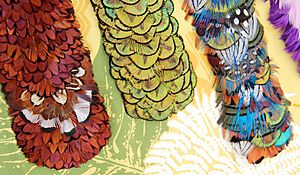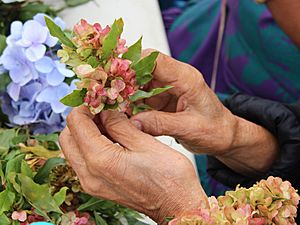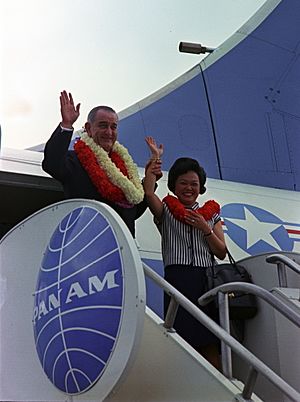Lei (Hawaii) facts for kids
A lei is a special flower necklace from Hawaii. People often make leis using beautiful hibiscus or orchid flowers. In Hawaii, May First is a special day called "Lei Day."
Contents
What Leis Mean
People give leis for many reasons. They often show peace, love, honor, or friendship. Leis are common gifts at special events like graduations, weddings, and school dances. The type of material used in a lei can also give it a special meaning. For example, a lei made from hala fruit can mean love, desire, or change.
What Leis Are Made Of
A lei (the plural is nā lei in the Hawaiian language) can be made from almost anything. Most often, they are made from fresh natural things. These include flowers, leaves, vines, fern fronds, and seeds.
Some popular flowers for leis are plumerias, tuberose, carnations, orchids, and pikake. Leaves like maile and tī are also very popular. They are traditional for hula dancers.
Other leis can be made from sea shells, land shells, fish teeth, bones, or feathers. Some modern leis use plastic flowers, fabric, paper (like origami or money), or candy. Anything that can be strung together and worn as a necklace or wreath can become a lei. The Hawaiian island of Ni‘ihau is famous for its leis made from tiny, gem-like shells.
How Leis Are Made
There are several common ways to make a lei:
- Haku: This method braids materials together. You start with a base, like soft tree bark or long leaves. Then you braid it while adding flowers or other decorations. This is good for plants with long, flexible stems.
- Hili: This is a simple braid using only one type of material. It often uses three or more strands of flexible vines or ferns braided together.
- Hilo: This method twists two strands together to form a "rope." The popular lei lāʻī (made from tī leaves) uses this twisting method.
- Hipuʻu / nipuʻu: This is like making a daisy chain. You knot the stem of one flower and string the next stem through that knot. It needs plants with very long stems.
- Humu / humuhumu: This method involves sewing materials onto a backing. The backing can be hala leaves, paper, or felt. Each new row of material overlaps the last, creating a scale-like look.
- Kui: This is probably the most well-known method. You use a needle to pierce the flowers or other materials. Then you string them onto a thread. This is often used for plumeria, rose, or carnation leis.
- Wili: This method involves winding a fiber around short pieces of the decorative material. It creates a corkscrew shape. Sometimes, base materials like hala or raffia are used to make the winding easier.
- Haku mele: This is not a physical lei. It means "to braid a song." A song written out of love for someone is also considered a lei.
Leis can be either open (like a necklace) or closed (like a wreath), depending on the occasion.
History of Leis
Leis were first worn by ancient Polynesians and some Asian people. They were part of their customs. Native Hawaiians often wore leis to show their high rank or royalty. They also wore them to honor each other and their gods. The religion and hula traditions of Native Hawaiians are closely linked to the leis they wore. When Polynesians came to the Hawaiian islands, they brought the tradition of making and wearing leis with them.
Today, on May 1st each year, people celebrate Lei Day. This day honors the art of making leis and the traditions around them.
Lei Customs
There are many special ways to give, receive, wear, store, and get rid of leis. When giving a lei, traditionalists bow slightly and hold the lei above their heart. The person receiving it then takes it. It is considered disrespectful to raise your hands above someone's head or touch their face or head.
If someone cannot wear a lei, perhaps due to allergies, they should display it in a place of honor. This could be on a music stand or microphone stand for a musician. Leis should never be thrown away like regular trash. Traditionally, they should be returned to nature. You can hang them in a tree, bury them, or burn them. A lei represents love, so throwing it away is like throwing away the love from the giver. Many leis can be left in a window to dry. This lets their natural smell fill the room.
Leis in Polynesia
In Polynesian cultures, a lei is something made and given to someone to decorate them. It is usually a sign of affection. Leis are given for greetings, goodbyes, love, friendship, appreciation, or congratulations.
In Samoa, similar garlands are called "asoa" or "ula." They are made from flowers, seeds, shells, or leaves. Single flowers worn in the hair are called sei. In Tahiti, these garlands are called "hei," and in the Cook Islands, they are called an "ei." Tongans make unique "kahoa" leis. These are chains of flat, crescent, or triangle shapes made from flower petals and leaves sewn onto a backing.
Today, many Polynesian celebrations include giving and receiving leis. Some modern leis are made from candy, folded money, or even food items like spam musubi. People also use "non-traditional" materials like ribbon, sequins, or yarn to make leis.
Leis in Hawaii
In Hawaii, people often wear nā lei for birthdays, graduations, weddings, funerals, retirement parties, and bridal showers. It's common to see high school or college graduates wearing so many leis that they reach their ears!
Every year on May 1st, Hawaiians celebrate "Lei Day." This idea started in 1927 with a poet named Don Blanding. A columnist named Grace Tower Warren came up with the famous phrase, "May Day is Lei Day." The Hawaiian song, "May Day is Lei Day in Hawaii," was written in 1927 by Ruth and Leonard "Red" Hawk.
In 2008, Honolulu set a record for the World's Longest Lei at the Mayor's Lei Day Celebration. It was over a mile long!
All the main Hawaiian islands celebrate Lei Day. Each island has its own special lei and color that represents it:
- Hawaiʻi: red, ʻōhiʻa lehua (Metrosideros polymorpha)
- Maui: pink, lokelani (Rosa damascena)
- Kahoʻolawe: gray or silver, hinahina (Heliotropium anomalum var. argentum)
- Lānaʻi: orange, kaunaʻoa (Cuscuta sandwichiana)
- Oʻahu: yellow or gold, ʻilima (Sida fallax)
- Molokaʻi: green, kukui (Aleurites moluccanus)
- Kauaʻi: purple, mokihana (Melicope anisata)
- Niʻihau: white, pūpū o Niʻihau (Niʻihau shells)
Images for kids
-
Prince Alexander Liholiho wearing a lei garland
-
Queen Emma is wearing many strands of lei pūpū ʻo Niʻihau
-
Young hula dancers wearing kukui nut leis before a performance on Molokai.
-
Lei of plumeria flowers and 'umi'umi-o-dole (Spanish moss) on an outrigger canoe during a blessing.
See also
 In Spanish: Lei hawaiano para niños
In Spanish: Lei hawaiano para niños












